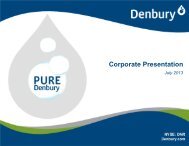Interactive 2009 Annual Report (PDF 7.56 MB) - Denbury Resources ...
Interactive 2009 Annual Report (PDF 7.56 MB) - Denbury Resources ...
Interactive 2009 Annual Report (PDF 7.56 MB) - Denbury Resources ...
- No tags were found...
Create successful ePaper yourself
Turn your PDF publications into a flip-book with our unique Google optimized e-Paper software.
78 <strong>Denbury</strong> <strong>Resources</strong> Inc. <strong>2009</strong> <strong>Annual</strong> <strong>Report</strong>independent engineers. To evaluate our CO 2 assets for impairment, we determine the CO 2 required for our provedtertiary reserves and include the estimated net capitalized costs of those CO 2 assets in the oil and natural gas ceilingtest. The remaining net capitalized CO 2 asset cost is evaluated for impairment by comparing our expected futurerevenues from these assets to their net carrying value.CO 2 PipelinesCO 2 pipelines are used for transportation of CO 2 to our tertiary floods from our CO 2 source field located nearJackson, Mississippi. We are continuing expansion of our CO 2 pipeline infrastructure with several pipelines currentlyunder construction. At December 31, <strong>2009</strong> and 2008, we had $779.1 million and $402.0 million of costs, respectively,related to construction in progress, recorded under “CO 2 properties, equipment and pipelines” in our ConsolidatedBalance Sheets. These costs of CO 2 pipelines under construction were not being depreciated at December 31, <strong>2009</strong>or December 31, 2008. Depreciation will commence when the pipelines are placed into service. The Green Pipeline,which had $766.9 million in cost, including capitalized interest, at December 31, <strong>2009</strong>, is expected to be placed intoservice during 2010. Each pipeline is depreciated on a straight-line basis over its estimated useful life, which rangesfrom 20 to 30 years. We include the net capitalized cost of the pipelines which provide CO 2 to the tertiary floods thathave proved tertiary reserves, in the oil and natural gas ceiling test.GoodwillWe recorded goodwill during <strong>2009</strong> in conjunction with our Hastings Field and Conroe Field acquisitions (see Note 2,“Acquisitions and Divestitures”). Goodwill represents the excess of the purchase price over the estimated fair value ofthe net assets acquired in the acquisition of a business. Goodwill is not amortized, but rather it is tested for impairmentannually during the fourth quarter and also when events or changes in circumstances indicate that the fair value of areporting unit with goodwill has been reduced below carrying value. The impairment test requires allocating goodwilland other assets and liabilities to reporting units. In the case of <strong>Denbury</strong>, we have only one reporting unit. The fair valueof the reporting unit is determined and compared to the book value of the reporting unit. If the fair value of the reportingunit is less than the book value, including goodwill, the recorded goodwill is impaired to its implied fair value with acharge to operating expense. We completed our annual goodwill impairment test during the fourth quarter of <strong>2009</strong> anddid not record goodwill impairment during <strong>2009</strong>.Cash EquivalentsWe consider all highly liquid investments to be cash equivalents if they have maturities of three months or less at thedate of purchase.Restricted Cash and InvestmentsAt December 31, <strong>2009</strong> and 2008, we had approximately $22.8 million and $7.4 million, respectively, of restricted cashand investments held in escrow accounts for future site reclamation costs. These balances are recorded at amortizedcost and are included in “Other assets” in the Consolidated Balance Sheets. The estimated fair market value of theseinvestments at December 31, <strong>2009</strong> and 2008 was approximately the same as amortized cost.Net Income Per Common ShareBasic net income per common share is computed by dividing the net income attributable to common stockholdersby the weighted average number of shares of common stock outstanding during the period. Diluted net income percommon share is calculated in the same manner, but also considers the impact to net income and common shares forthe potential dilution from stock options, non-vested stock appreciation rights (“SARs”), non-vested restricted stockand any other convertible securities outstanding.All shares have been adjusted for the 2-for-1 stock split effective December 5, 2007. For each of the three years inthe period ended December 31, <strong>2009</strong>, there were no adjustments to net income for purposes of calculating basic anddiluted net income per common share.Form 10-K Part IINotes to Consolidated Financial Statements




